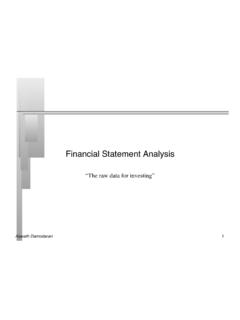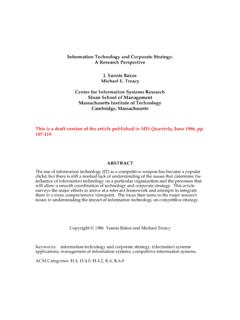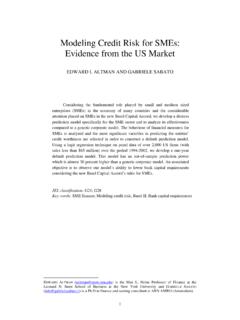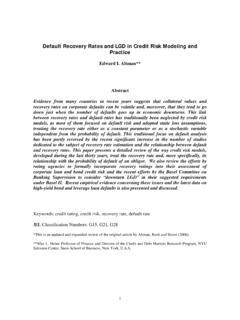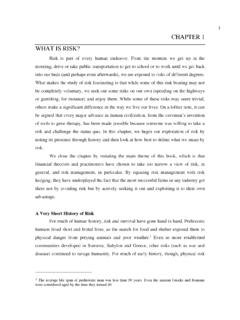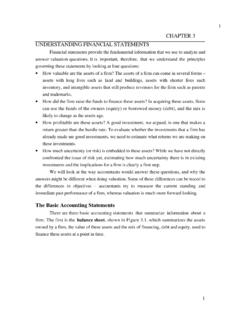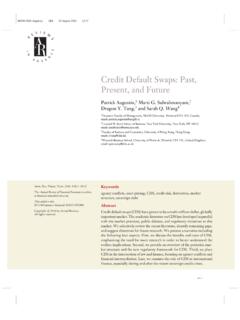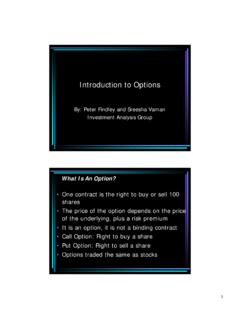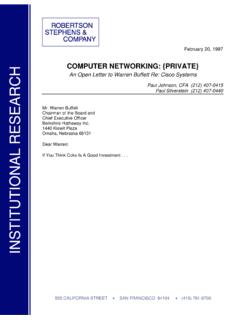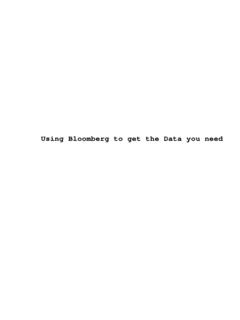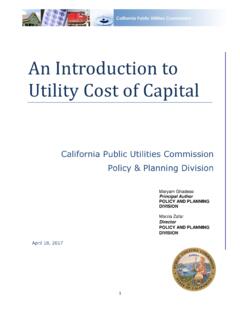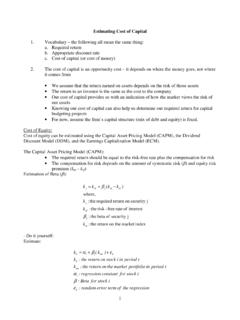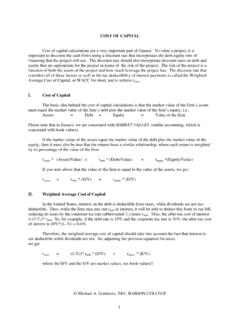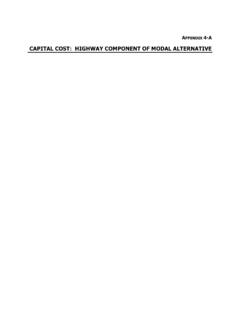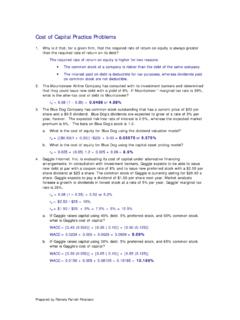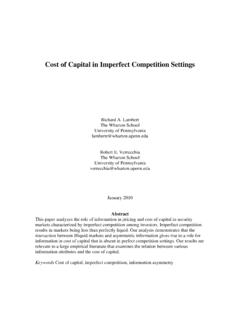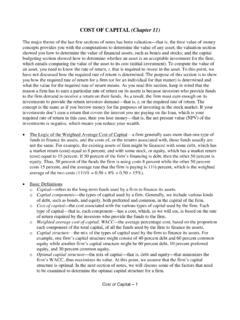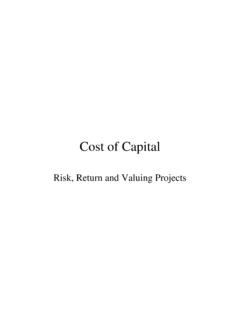Transcription of Aswath Damodaran April 2016 Abstract - New York University
1 The cost of capital : The Swiss Army Knife of Finance Aswath Damodaran April 2016 Abstract There is no number in finance that is used in more places or in more contexts than the cost of capital . In corporate finance, it is the hurdle rate on investments, an optimizing tool for capital structure and a divining rod for dividends. In valuation, it plays the role of discount rate in discounted cash flow valuation and as a control variable, when pricing assets. Notwithstanding its wide use, or perhaps because of it, the cost of capital is also widely misunderstood, misestimated and misused. In this paper, I look at what the cost of capital is trying to measure and how best to avoid the pitfalls that I see in practice.
2 What is the cost of capital ? If you asked a dozen investors, managers or analysts this question, you are likely to get a dozen different answers. Some will describe it as the cost of raising funding for a business, from debt and equity. Others will argue that it is the hurdle rate used by businesses to determine whether to invest in new projects. A few may use it as a metric that drives whether to return cash, and if yes, how much to return to investors in dividends and stock buybacks. Many will point to it as the discount rate that is used when valuing an entire business and some may characterize it as an optimizing tool for the deciding on the right mix of debt and equity for a company.
3 They are all right and that is the reason the cost of capital is the Swiss Army knife of Finance, much used and oftentimes misused. The Mechanics The cost of capital , in its most basic form, is a weighted average of the costs of raising funding for an investment or a business, with that funding taking the form of either debt or equity. The cost of equity will reflect the risk that equity investors see in the investment and the cost of debt will reflect the default risk that lenders perceive from that same investment. The weights on each component will reflect how much of each source will be used in financing the investment. Figure 1 captures the key ingredients.
4 Figure 1: cost of capital Ingredients This relatively simple construct has estimation questions embedded in it, including how equity investors perceive risk and convert that risk into a required return and what lenders consider in making their judgments on the default spread. There are also questions about what tax rate, the effective or the marginal, to use in the assessment to best capture the tilt in the tax code towards debt. If you make it through the mechanics of computing cost of capital , you will see it described as an opportunity cost , a discount rate and a hurdle rate for investments and it is all of the above depending upon where it is being used and by whom, as delineated in figure 2: Figure 2: The cost of capital as Swiss Army Knife For investors in companies, the cost of capital is an opportunity cost in the sense that it is the rate of return that they would expect to make in other investments of equivalent risk.
5 For the companies themselves, it becomes a cost of financing, since they have to deliver returns that beat or at least match the cost of capital to keep investors happy. Finally, within the company, especially if it is in multiple businesses, the cost of capital can take the form of a hurdle rate on investments, though it can be different for different businesses, if they have different risk profiles. Role in Corporate Finance All businesses have to decide whether and where to invest scarce resources (the investment decision), what mix of debt and equity to use in funding these businesses (the financing decision) and how much cash (if any) to return to the owners of the business (the dividend decisions).
6 If corporate finance is the discipline that looks at these decisions, the cost of capital is an essential tool in each one. Investment Analysis It is undeniable that great businesses get built from making good investment judgments and that good businesses can be destroyed by bad ones. But what separates a good investment from a bad one? In the corporate finance world, it is the cost of capital that is the benchmark that has to be beaten for an investment to be categorized as a good investment, though there is still some disagreement about how best to measure the return on an investment. There are some who prefer to stick with accounting numbers and estimate a return on invested capital , computed as the ratio of operating income to invested capita, and comparing that return to the cost of capital .
7 There are others who put their faith in cash flows and estimate a net present value for an investment, where the cost of capital is used to discount future cash flows to the present. There are still others who compute an internal rate of return on the cash flows and compare those to the cost of capital . Figure 3: The cost of capital as Hurdle Rate Note the two cautionary notes at the bottom of the table, capturing common mistakes in investment analysis. The first is when a company insists on using its cost of capital on all investments, even if these investments are in different businesses and have different risk profiles. That will lead to safe businesses subsidizing risky businesses within the company and over time, the company itself will get riskier.
8 The other is when a specific project is funded disproportionately with debt, and the cost of capital is computed using that debt ratio. In this case, projects that are funded with less debt will subsidize the ones that are funded with more. capital Structure The second component in corporate finance is finding a financing mix that optimizes business value. Of course, you could take the Miller-Modigliani theorem to heart and argue that debt is of little consequence to value, but that view is indefensible in a world with taxes and default risk. Put differently, if you accept the argument that some firms can borrow too much and others too little, it follows that there is an optimal mix of debt and equity for a business and the only question is how you determine that optimal.
9 Here, the cost of capital can operate as an optimizing tool, where the mix of debt and equity that minimizes cost of capital is the one that the business should aspire to have, since, in effect, it maximizes the value of the business. To use the cost of capital as an optimizing tool, though, you have to be able to incorporate the effects of borrowing more into both your cost of equity and your cost of debt, since both are likely to increase as the debt ratio goes up, the former because equity investors will be exposed to more volatile equity earnings, after interest payments, and the latter because default risk will increase with the debt. Figure 4 includes these effects: Figure 4: cost of capital as Optimizing Tool Bankruptcy costs are built into both the cost of equity the pre- Tax benefit is tax cost of debt here Weight of Pre-tax cost of debt (1- tax Weight cost of Equity X + X.)
10 Equity rate) of Debt As you borrow more, he At some level of equity in the firm will As you borrow more, borrowing, your become more risky as your default risk as a tax benefits may financial leverage firm will increase be put at risk, magnifies business risk. pushing up your cost leading to a lower The cost of equity will of debt. tax rate. increase. The trade off: As you use more debt, you replace more expensive equity with cheaper debt but you also increase the costs of equity and debt. The net effect will determine whether the cost of capital will increase, decrease or be unchanged as debt ratio changes. While the conventional cost of capital approach is built around the assumption that the operating income of a company is unaffected by its debt policy, a simple extension would allow the operating income to change (dropping as a company's default risk increases) and the optimal debt ratio then would be the one that maximizes firm value (rather than minimize cost of capital ).
